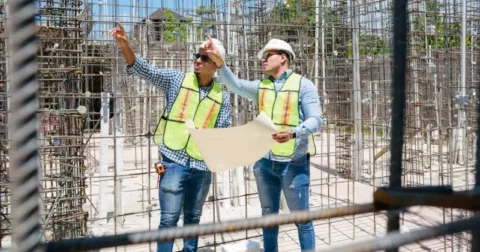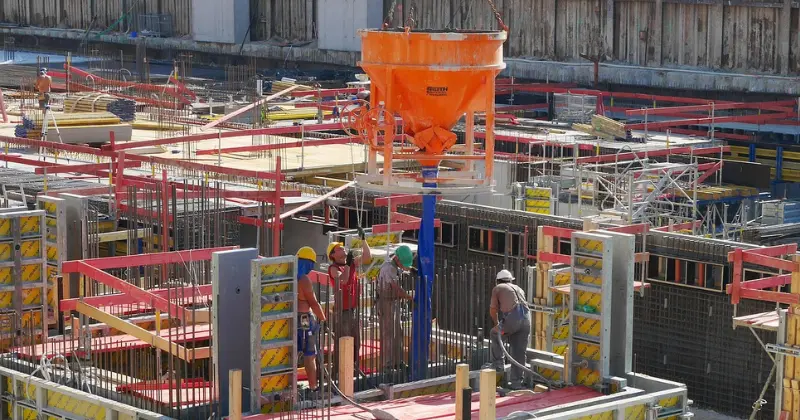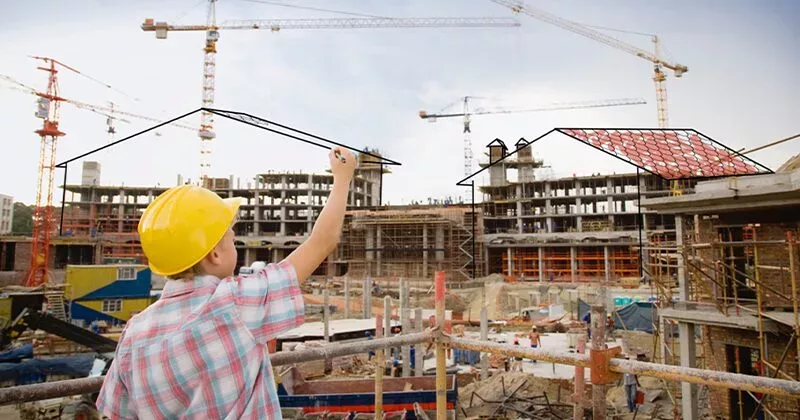10 mins read
Infrastructure Construction: A Deep Dive into the Definition, Types, and Current Trends
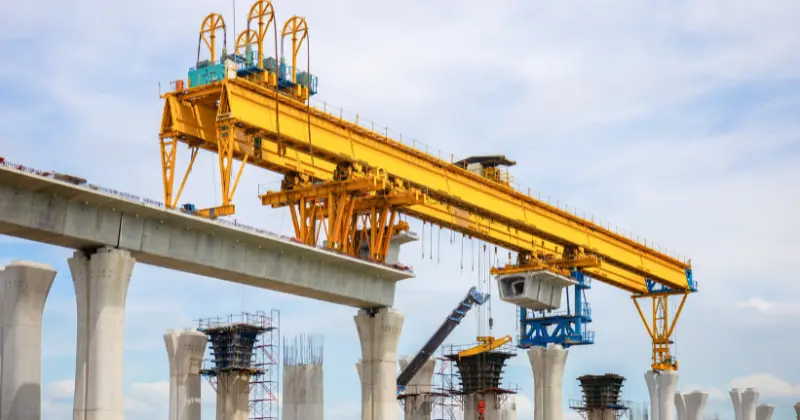
From the water we drink to the energy that lights our homes and cities to the bridges and roads that connect us, infrastructure construction is the silent engine that powers our everyday lives. This crucial sector of the building industry is all about designing, building, and maintaining the systems that power our economies and keep communities connected and safe.
As urbanization, the demand for traveling, and sustainability and renewable energy requirements grow, the infrastructure construction sector has never been more vital. This blog thoroughly explores this crucial part of our industry, highlighting how using the right technology can help achieve powerful results.
What is Infrastructure Construction?
Infrastructure construction focuses on designing, planning, and building structures that are crucial to the functioning of a society or industry, such as bridges, tunnels, railways, power plants, etc. These structures can be public, privately funded, or a combination of both.
Infrastructure construction projects are often challenging because they require a lot of resources and planning due to their size and complexity. A specialized team of technical experts is hired to handle the project’s unique needs, and heavy equipment and machinery are used at the site.
For centuries, infrastructure construction has been at the center of economic growth and overall development in communities. These projects improve the quality of life of those who use them; for example, a new bridge can improve connectivity and reduce the time people drive to work. Likewise, a new power plant with renewable energy sources can improve sustainability and lower energy bills for people in the long term. These projects also benefit the community by creating new job opportunities.
Private vs. Public Infrastructure
Depending on the infrastructure’s size, purpose, and location, projects are funded publicly, privately, or in a hybrid financing model.
Infrastructure projects like highways, bridges, and water treatment facilities are often publicly funded by the government with funds from taxes. Common challenges include budget constraints and political factors that can delay the project. Conversely, projects like power generation plants or industrial infrastructure are usually privately funded by corporations and private equity investors. Common challenges for this financing model include the need for a high return on investment (ROI).
Public-private partnerships, or PPPs, are collaborations between private companies and the government. In a PPP, the private party finances, builds, and sometimes operates public infrastructure in return for a revenue agreement with the government. This agreement helps the government share financial risk while leveraging the expertise of the private sector. However, if the risks are not adequately managed and shared, it can lead to economic losses, making effective preconstruction planning fundamental.
Types of Infrastructure Construction Projects
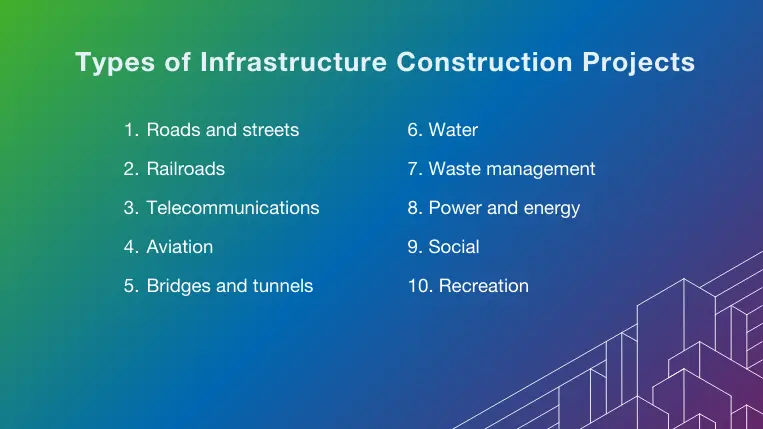
Construction infrastructure keeps communities moving and living safely and efficiently, as most structures, like energy, water, or communications, are fundamental for people’s daily lives. Below, we explore the different types of infrastructure construction projects to keep putting their value in perspective.
● Roads and streets: These are the most common type of infrastructure as they are fundamental for granting quality transportation access to communities. Road and street infrastructure projects often include repairs, expansions, or new systems for the most congested areas.
● Railroads: Railroad infrastructure, such as trains and subways, is currently among the most sought-after projects. Most big cities worldwide have train and subway systems that are too old and require repairs or expansions.
● Telecommunications: As the name suggests, this infrastructure connects people through signal towers, fiber optic cables, wires, antennas, and satellites. These projects are often constructed quickly and require continuous monitoring to prevent outages and ensure everything is up to date.
● Aviation: Aviation infrastructure projects involve developing and maintaining airports. In the past few years, many airports have been expanded to meet the increasing demand for air travel worldwide.
● Bridges and tunnels: Bridges and tunnels are some of the most complex infrastructure projects, especially bridges. Work is completed over water and around flowing traffic, so it can take a long time to complete.
● Water: Water is a fundamental resource, making these types of infrastructure projects the most demanding and important ones on this list. Water-related infrastructure projects include water distribution systems, water treatment centers, and storage facilities like towers or canals, among many others. Most existing water systems are outdated and require continuous repairs or updates to integrate new technologies and innovations.
● Waste management: Waste management infrastructure ensures hazardous materials are not everywhere. Because some of the waste handled in these facilities is dangerous, they must follow strict safety guidelines.
● Power and energy: Electrical lines, power towers, and renewable energy systems are a few of the various existing power and energy infrastructure projects. These projects involve repairing, maintaining, and replacing old systems with innovative alternatives.
● Social: These are the infrastructure projects necessary for the effective functioning of a society, such as hospitals, schools, and government buildings.
● Recreation: Last but not least, we have recreation infrastructure for public use, such as parks, picnic areas, or playgrounds. They are often built within neighborhoods to improve outdoor life and health.
The Current State of Infrastructure Construction: Key Trends & Statistics
The infrastructure construction sector is one of the key activity drivers in the building industry, with governments worldwide investing in large-scale infrastructure projects to boost economic growth. According to the “Global Infrastructure Outlook to 2028” from GlobalData, the sector has had an average annual growth of 8.1% in the past five years, and it is expected to grow at a yearly rate of 7.6% between 2026 and 2028. This growth is expected due to significant spending plans from key economies like the US, India, and China.
A closer look at the current state of the infrastructure sector in the US shows a positive picture, with an expected average growth rate of 11.5% between 2025 and 2028, as stated in the GlobalData report. The growth mainly comes from large government investments in transportation networks for projects like the $11.4 billion Honolulu Rail Transit project or the $5.3 billion Red Line Extension project.
The GlobalData report also highlights some positive developments in Asia Pacific, specifically in Australia, with an expected 2.8% average annual growth between 2025 and 2028, mainly due to the need to improve public infrastructure, increasing urbanization, and interest in renewable energy. For instance, Queensland’s Big Build program invests in road and rail infrastructure to address the congestion caused by increased population. Another example is the recently signed AUD1.5 billion ($1 billion) contract between the Italian construction company Webuild, South Korean construction company GS Engineering and Construction, and French company Bouygues for the excavation of two parallel tunnels of 10km each in Melbourne by 2026 to improve connectivity and reduce congestion. These are just two of the several infrastructure initiatives happening in Australia. The graph below shows the road and rail construction output from 2019 to 2028, highlighting the increase in rail and road projects.
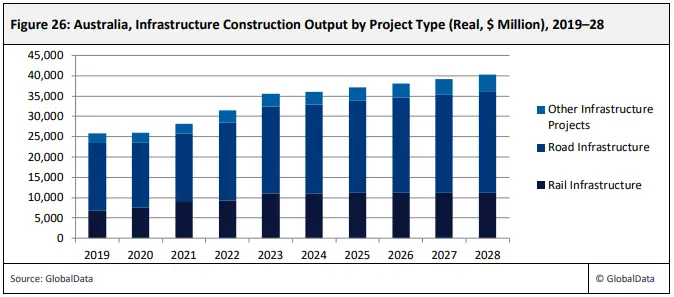
Returning to the global outlook, the GlobalData report highlights some trends in each infrastructure sector. Some of these include:
Railway
China remains the major contributor to global railway infrastructure output, accounting for 44.7% of the total. The railway sector is expected to continue its transformation by adopting technologies like Artificial Intelligence (AI), the Internet of Things (IoT), and big data to “optimize operations, enhance passenger experiences, and align with global sustainability goals.
Roads
The roads sector saw a global output increase of 3.6% in 2024. However, despite this positive growth, the demand for road infrastructure differs significantly from region to region. The US and China have seen increased road investment, while Europe, the Middle East, Africa, and Latin America have seen public investments soften.
Electricity, power, and renewables
Like railways, China dominates the electricity, power, and renewables sector, accounting for 46.3% of the total output value. North America (11.4%) and South Asia (11.1%) follow. The electricity infrastructure sector is expected to grow 7.7% during the 2025–2028 period, with a shift from fossil fuel-based power generation to renewable energy sources like wind or solar. This shift has also resulted in innovations in energy storage to address the intermittent nature of renewable energy sources.
Water and sewerage
The global water and sewerage infrastructure output is dominated by projects in the Middle East and North Africa region, accounting for 42.5% of the total. This reflects the region’s dependency on seawater desalinizing and recycling wastewater for its potable water supply.
The water and sewerage infrastructure sector is expected to grow significantly in the coming years, thanks to the “rising global population, decreasing freshwater supplies, increased demand for wastewater treatment,” and other factors. Trends include investments in technology and a focus on energy efficiency and eco-friendly products. Several water treatment facilities are expected to be built to fight the urgent global issue of water scarcity.
Airports and ports
Unlike other sectors, the airport and port sector saw a decrease in growth from 11% in 2023 to 5% in 2024. From 2025 to 2028, the sector’s growth is expected to stabilize with an annual average rate of 3.6%, with North America leading the way. The development is mainly explained by the increasing demand for air travel, which has led to the construction or expansion of several airports across the world. Another reason for growth is sustainability, as existing infrastructure is remodeled to include eco-friendly materials and practices.
The global port market is also growing due to changes in international trade dynamics, sustainability, and technological integration. As ports are among the highest carbon emitters, there is a strong push towards decarbonization.
The Power of Infrastructure Construction Software
Infrastructure construction software is vital in streamlining the planning, design, and management of complex infrastructure projects. From highways and bridges to utilities and public facilities, this type of software helps teams organize data, automate documentation, and improve collaboration across disciplines. It enables contractors, engineers, and owners to work with accurate, coordinated, and up-to-date information, reducing errors and delays during construction.
RIB CX is professional construction infrastructure software equipped with a range of functionalities designed to improve office and field productivity and ensure infrastructure projects finish on time and within budget. Below, we explore what this powerful solution can do for you.
● Centralized project management: RIB CX offers multiple modules for contract administration, tenders, defect management, construction quality management, and more, all integrated into a single system that all stakeholders can access. This prevents data loss and significantly boosts collaboration
● Mitigate risks across projects: Powerful construction risk management features ensure any potential issues are quickly identified and resolved before they can impact the schedule or budget. A mobile-based defects tracking system allows teams to capture, assign, and resolve problems in real-time. Defects can be recorded with an image for better clarity and linked to relevant items like variations, claims, and RFIs.
● Effective document control: RIB CX’s publication space is a document control module where the different stakeholders can share files like drawings, reports, contracts, schedules, and more, in a secure and easily accessible environment. This facilitates collaboration, ensuring a swift approach to construction document management.
● Streamlined cost management: With RIB CX, companies can manage multiple infrastructure projects in real time. The module allows for generating budgets with accurate estimates, variation management, cost breakdowns, and payment schedules for better contract and financial control.
● Customizable to your needs: Each infrastructure project has unique demands and complexities. Users can design their layout in RIB CX, adding reporting fields that suit specific requirements. Real-time dashboards and analytics functionalities help track progress and performance, spot potential issues, and fix them to achieve the expected quality and goals.
Real-World Success Cases of Construction Infrastructure Software
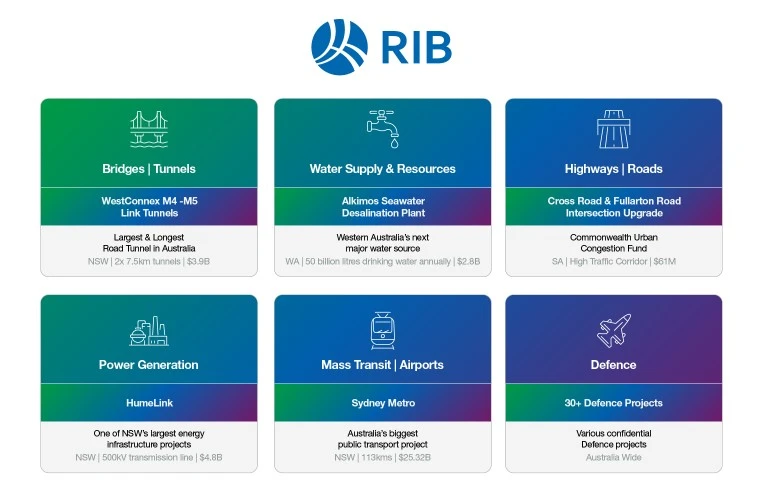
Now that you better understand the impact a software like RIB CX can have, let’s explore some real-world construction infrastructure examples in Australia and New Zealand where the platform played a crucial role.
- WestConnex M4-M5 Link Tunnels
The WestConnex M4-M5 Link Tunnels are a set of 7.5km twin tunnels connecting the M4 at Haberfield to the M8 at St Peters, effectively creating a western bypass of Sydney’s central business district. These tunnels are a pivotal component of Sydney’s extensive motorway project, with construction starting in 2018 and finishing in 2023. RIB CX played a crucial role in this project, especially for contracts management, progress claims, variations, budget vs actuals, all with real-time reporting, cashflow management, and forecast to final completion.
- Alkimos Seawater Desalination Plant
The Alkimos Seawater Desalination Plant (ASDP) was planned to reduce the area’s dependence on rainfall and groundwater and help provide secure, sustainable drinking water. Construction of the ASDP started in late 2023, and the first water production is planned for 2028. The infrastructure, built on Water Corporation Land, will be hidden behind large, vegetated sand dunes to absorb noise and protect the place’s visuals. RIB CX has been a great partner for quality control, managing Work Packs and ITPs, helping ensure compliant delivery during construction with a comprehensive and easy handover of documentation.
- Cross Road and Fullarton Road Intersection Upgrade
The Australian and South Australian Governments joined forces to upgrade the Cross Road and Fullarton intersection. The project, which was announced as part of the 2019-2020 State Budget, focused on improving traffic flow to reduce congestion, minimize accidents, and improve overall transportation efficiency at a key intersection in Adelaide, South Australia. RIB CX was a crucial collaboration platform for controlling data sharing, automation, workflows, and approval processes.
- HumeLink
HumeLink is a significant infrastructure project designed to enhance the electricity transmission network in New South Wales. The 500kV transmission line connecting Wagga Wagga, Bannaby, and Maragle is the largest energy infrastructure project in the state, supporting Australia’s transition to a greater mix of low-emission renewable energy sources. CX helped in quality control by effectively managing Work Packs and ITPs, ensuring compliant construction delivery and effective handover of project information.
- Sydney Metro
Sydney Metro is Australia’s largest public transport project, delivering a new stand-alone metro railway system to Sydney. The project’s first stage was the Metro North West Line, a 36-kilometer line with 13 stations connecting Tallawong to Chatswood, which opened in May 2019. The City & Southwest is the second stage, which is currently under construction as an extension that will run from Chatswood, through the Sydney central business district, and onto Bankstown, with a scheduled completion in 2024. The third stage, West, is planned to link the Sydney central business district with Greater Parramatta, aiming to decrease travel times and congestion. CX has played a crucial role as the software partner for quality control, document management, and effective handover.
- Defense Projects
Lastly, RIB CX has been involved in over 30 confidential defense projects across Australia, contributing to robust risk and quality management, secure collaboration, contracts, financial management, and more.
Final Thoughts
Infrastructure construction involves more than just buildings, bridges, or roads. These projects are the backbone of communities, facilitating growth, connectivity, and essential resources like water and energy. They also boost economic growth with new job opportunities and investments for a more sustainable future.
As cities expand and environmental challenges grow, the need for innovative, resilient, and sustainable infrastructure has never been greater. Professional infrastructure construction software plays a crucial role in the success of these initiatives. From design and planning to project delivery, modern infrastructure solutions, like RIB CX, help teams coordinate complex data, automate documentation, and enhance collaboration, leading to higher quality outcomes and fewer costly errors.
If you want to experience the powerful functionalities of RIB CX, get your free demo today!
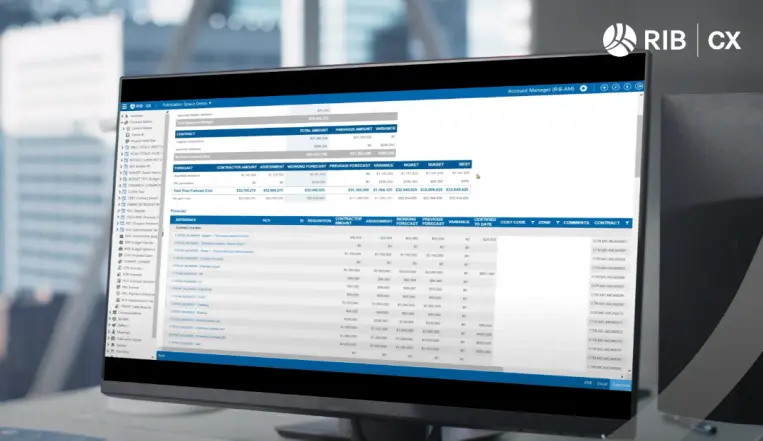
Most Recent
10 mins read
11 mins read
11 mins read
10 mins read
Blog Categories
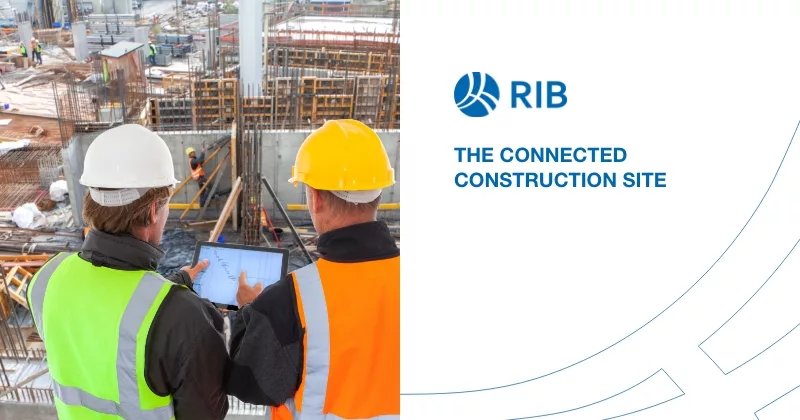
Ebook
